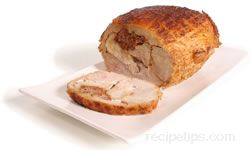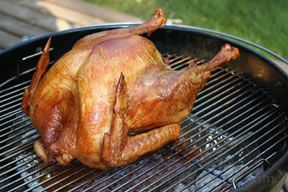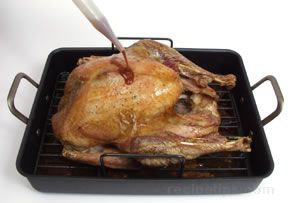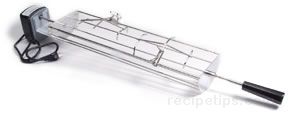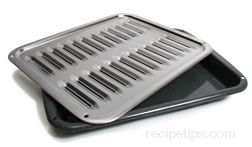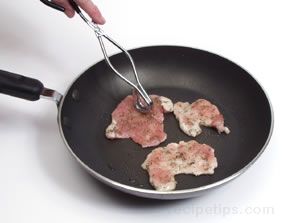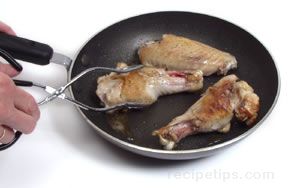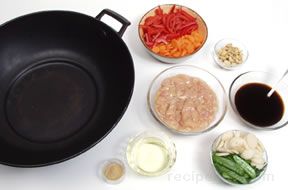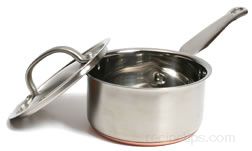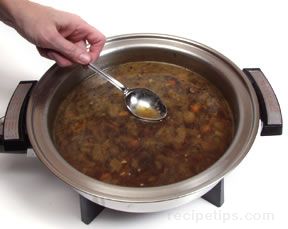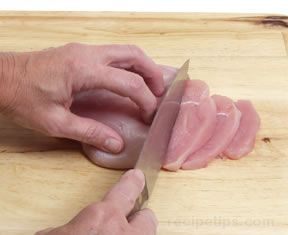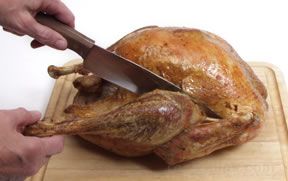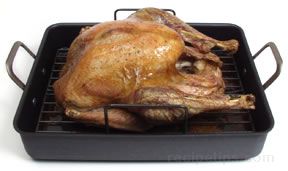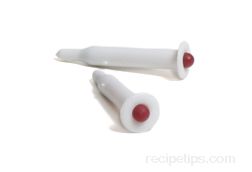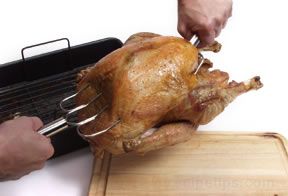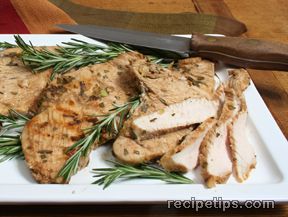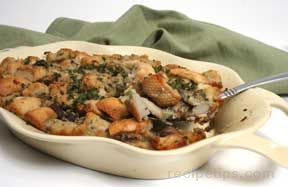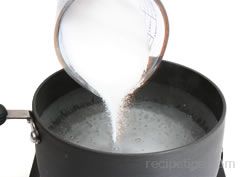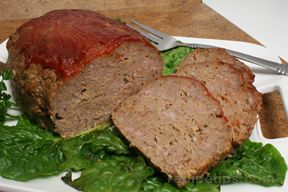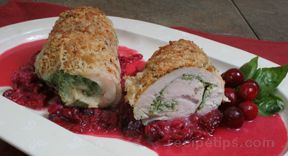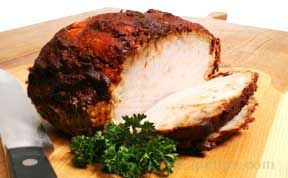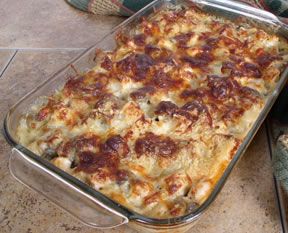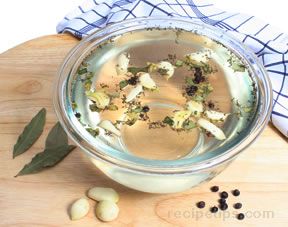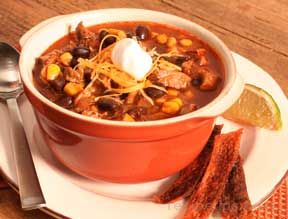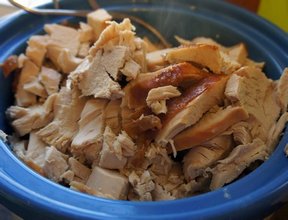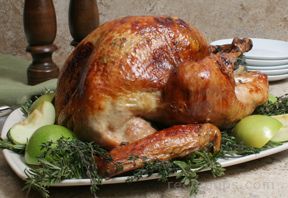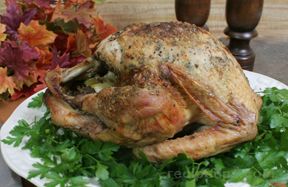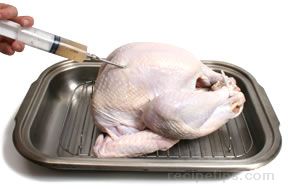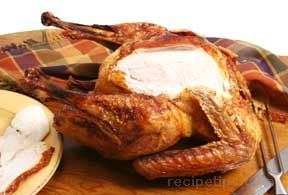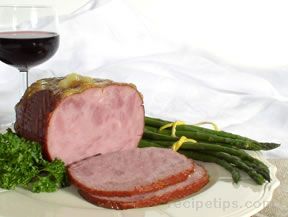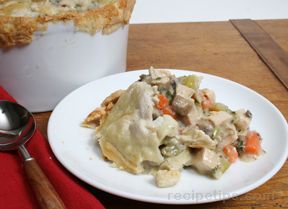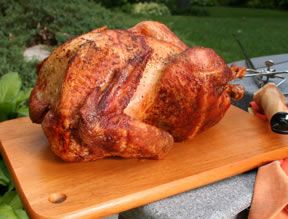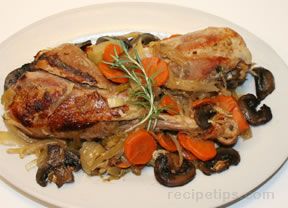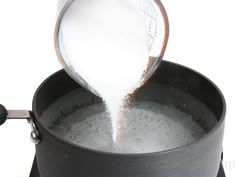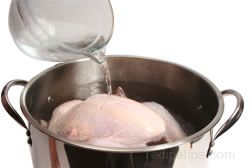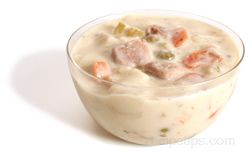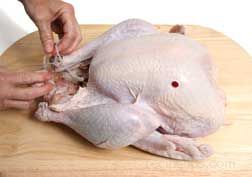General Guidelines for Proper Doneness
Meat Thermometers | Unsafe Cooking Methods
General Guidelines for Proper Doneness
|
Consider the Following Points when 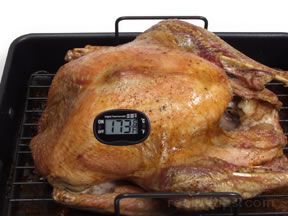
| |
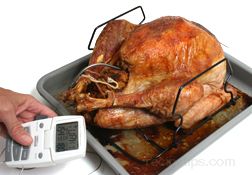
| |
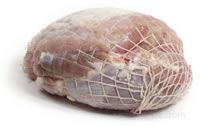
|
|

| |
|
A meat thermometer should be used to verify that turkey meat has reached the proper doneness. An ovenproof thermometer can be placed into a whole turkey and remain there throughout the roasting process. An instant read thermometer can be used to check the temperature of the turkey, but it cannot be left in the bird during cooking because it is not heatproof. Some whole turkeys are sold with pop-up timers that indicate when the turkey is fully cooked, but a meat thermometer is still the most reliable tool for determining the proper doneness. Shown below are a dial face ovenproof thermometer and an instant read digital meat thermometer that can be used to check the internal temperature of turkey to ensure proper doneness. There are several varieties of ovenproof and instant read thermometers available. |
|
An Ovenproof Thermometer and a Digital Instant Read Thermometer |
|
|
To ensure that a meat thermometer is accurate, it can be placed into water and ice for about 5 minutes and the temperature should read 32°F. For the most accurate measurement, the stem should be inserted about 2 ½ inches into the ice water and should not be allowed to touch the sides of the container. If the temperature does not register 32°F, the thermometer can be adjusted with a setscrew usually found on the back of the dial. |
| Note: It is recommended that ground turkey dishes be checked for doneness with a meat thermometer. This is especially important when the meat has been blended with other ingredients or dark sauces that can mask the color of the meat, making it difficult to visually determine the proper doneness. If stuffing has been cooked inside the turkey, the temperature of the stuffing must be checked with a meat thermometer to ensure that it has reached a minimum safe temperature of 165°F. |
|
The following methods for preparing and cooking Partial Cooking Some home cooks have the mistaken idea that time can be saved by roasting a turkey only partially on the day before it is to be served and then placing it back into the refrigerator so that less roasting time will be required on the day the meal will be served. This is a dangerous practice, which encourages harmful bacteria to multiply at a very rapid rate, resulting in food poisoning. Once begun, the cooking process should be allowed to continue until the turkey is cooked completely. Use a meat thermometer to determine the safe internal temperature. Overnight Slow Cooking Cooking a whole turkey slowly overnight at a low temperature is very dangerous. Often, the turkey is cooked overnight for 12 to 14 hours at a temperature of about 200°F, which allows harmful bacteria to grow rapidly before the turkey reaches a safe internal temperature (which may never occur at such a low roasting temperature). Turkey should never be oven roasted at a temperature of less than 325°F. Brown Paper Bag This gimmick involves the placement of the turkey in a large, brown, paper shopping bag and cooking it for a long period at a low temperature. This is extremely unsafe because the low cooking temperature allows bacteria to multiply rapidly within the turkey. In addition, the paper bag is poor choice for use as a cooking vessel because the glue and ink that are used when the bag is manufactured may permeate the turkey when heated, creating a toxic situation. Trash Bag or Mississippi Trash Bag This odd method of preparing a whole turkey is extremely unsafe. The turkey is placed in a large plastic trash bag containing a marinade and is left at room temperature for several hours. A turkey should never be left at room temperature for such long periods because harmful bacteria may multiply rapidly as the interior of the turkey warms beyond 40ºF. An item such as a trash bag, which is not designated as being safe to use with food, should never be used as a tool for food preparation even if the bag containing the food is refrigerated during the marinating period, (as is possible with this unsafe turkey preparation method). The bag may be manufactured with materials that are toxic; therefore, they are not suitable for contact with food. Turducken Turducken is a recipe that consists of a boned turkey layer covering a boned duck layer covering a boned chicken layer (thus the name, tur-duck-en). Stuffing is placed between each layer and it is then rolled and tied. Some traditional recipes call for turducken to be slowly roasted for as long as 14 hours in a 190°F oven, but this is a dangerous practice. Poultry should never be cooked at low temperatures for long periods of time, especially when it contains stuffing. When cooked at a low temperature, too many hours are required for the meat and stuffing to reach a safe internal temperature (which may never occur), so harmful bacteria can multiply rapidly during this lengthy period.
|
|
Note: Remember, the only recommended
|







